Global Sleep Tech Market By Type, By Product Type, By Application, By Distribution Channel, By Region & Segmental Insights Trends and Forecast, 2024 – 2034
- Industry: Healthcare
- Report ID: TNR-110-1304
- Number of Pages: 420
- Table/Charts : Yes
- September, 2024
- Base Year : 2024
- No. of Companies : 10+
- No. of Countries : 29
- Views : 10113
- Covid Impact Covered: Yes
- War Impact Covered: Yes
- Formats : PDF, Excel, PPT
Sleep tech refers to the use of technology to monitor, improve, and manage sleep health. In recent years, the sleep tech market has gained prominence as people increasingly recognize the impact of sleep on overall well-being. Sleep disorders, like insomnia and sleep apnea, have driven demand for innovative solutions. The market includes products such as smart mattresses, sleep trackers, and CPAP machines for apnea.
For example, in 2023, Fitbit introduced advanced sleep monitoring features, making sleep data accessible to users. Sleep tech is especially popular among Millennials and Gen Z, who prioritize wellness and adopt wearable technologies. Applications of sleep tech range from personal health tracking to clinical tools for diagnosing sleep disorders in healthcare settings. In terms of revenue, the global sleep tech market was worth US$ 18.4 Mn in 2023, anticipated to witness a CAGR of 17.5% during 2024 – 2034.
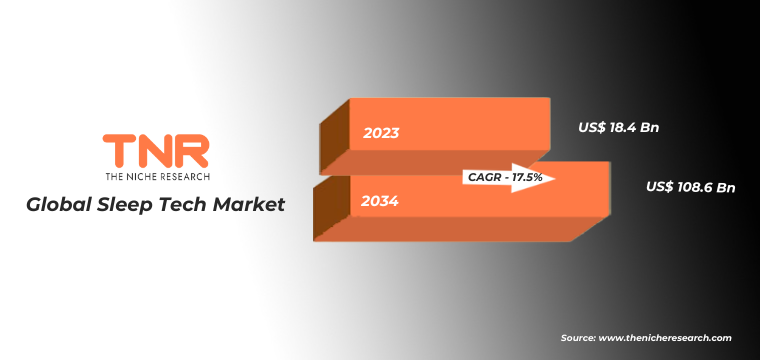
Global Sleep Tech Market Dynamics
Growth Drivers-
- Rising Awareness of Sleep Health: Increasing awareness of the importance of sleep in maintaining overall health and preventing chronic conditions, such as cardiovascular diseases and mental health issues, is driving the adoption of sleep tech products like smart sleep trackers and wearables.
- Technological Advancements in Wearables: Innovations in wearable technology, including smartwatches and fitness trackers with advanced sleep monitoring features, are fueling market growth. These devices provide real-time insights into sleep patterns, enabling users to improve sleep quality and manage sleep-related disorders.
Restraints-
- High Cost of Advanced Devices: The high price of advanced sleep tech products, such as smart mattresses and sophisticated sleep apnea machines, limits their accessibility, particularly in price-sensitive markets. This poses a barrier to widespread adoption, especially in developing regions.
- Privacy and Data Security Concerns: Growing concerns over the collection and use of personal data by sleep tech devices, particularly wearables, are restraining market growth. Users may hesitate to adopt these technologies due to potential privacy issues related to sleep data sharing and security.
Sleep Tracker Users Started Tracking Their Sleep In Past Year
In the past year, a growing number of sleep tracker users have begun actively monitoring their sleep patterns, driven by increasing awareness of sleep health. For example, Fitbit reported a significant rise in users engaging with its sleep tracking features in 2023, as individuals seek to better understand and improve their sleep quality. This trend reflects a broader shift towards personalized health management, with users leveraging data from sleep trackers to make informed lifestyle adjustments and address sleep-related issues effectively.
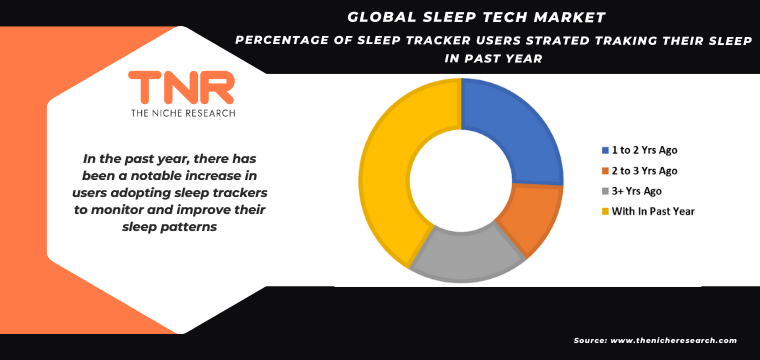
Global Sleep Tech Market Revenue & Forecast, (US$ Million), 2016 – 2034
Global Sleep Tech Market By Type
In 2023, non-wearable sleep tech devices led the global market, accounting for a 50.5% revenue share. These devices, such as smart beds, mattresses, and room sensors, offer advanced, contactless sleep monitoring. For instance, Somnofy, launched by VitalThings in 2022, provides non-intrusive, clinical-grade sleep analysis without the need for wearables. Such devices appeal to consumers seeking comfort and convenience, especially those who find wearables intrusive during sleep. Non-wearable tech is also favored in healthcare settings, where continuous, accurate monitoring is essential for diagnosing sleep disorders like sleep apnea, further boosting their adoption across the market.
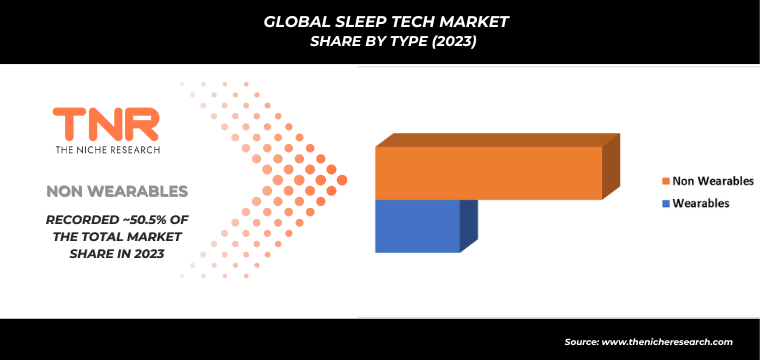
Global Sleep Tech Market By Product Type
Sleep aids segment emerged as the second-largest growing category in the global sleep tech market, capturing a 22.1% revenue share in 2023. This segment includes products like melatonin supplements, sound machines, and light therapy devices, all designed to enhance sleep quality. For example, Hatch Restore, a smart sound machine and sleep light, gained popularity since its 2020 launch for its ability to improve sleep patterns naturally. The rise in sleep disorders and increased consumer interest in non-invasive, drug-free solutions for better sleep health have fueled the growth of this segment within the sleep tech industry.
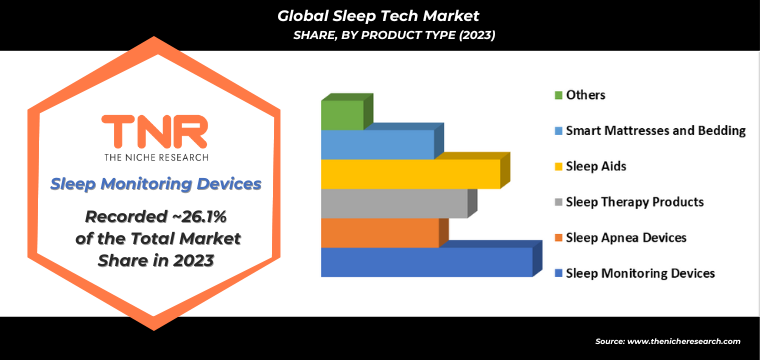
Global Sleep Tech Market By Application
Sleep tech products are more frequently used in professional use, such as hospitals and sleep clinics, than for home use. Devices like CPAP machines and advanced sleep monitoring systems are critical for diagnosing and treating sleep disorders in clinical environments. For instance, Guardian M10 by VitalThings, launched in 2022, offers continuous, contactless patient monitoring in healthcare settings, enhancing sleep disorder diagnostics. The need for accurate, reliable data in medical contexts has led to greater adoption of these technologies in professional settings compared to home environments.
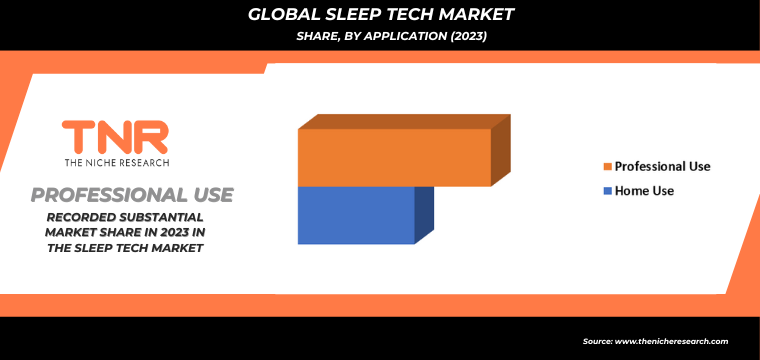
Global Sleep Tech Market By Distribution Channel
Offline channel dominated the global sleep tech market in 2023, with a revenue share of 78.2%. This dominance is attributed to consumers and professionals preferring physical stores and medical supply outlets for purchasing sleep tech products. Offline channels provide opportunities for hands-on product testing, expert consultations, and reliable after-sales services, especially for advanced devices like CPAP machines and smart beds. For instance, healthcare providers often rely on offline purchases to ensure product quality and technical support. The ability to interact with and assess products in person has reinforced the popularity of offline sales in the sleep tech market.
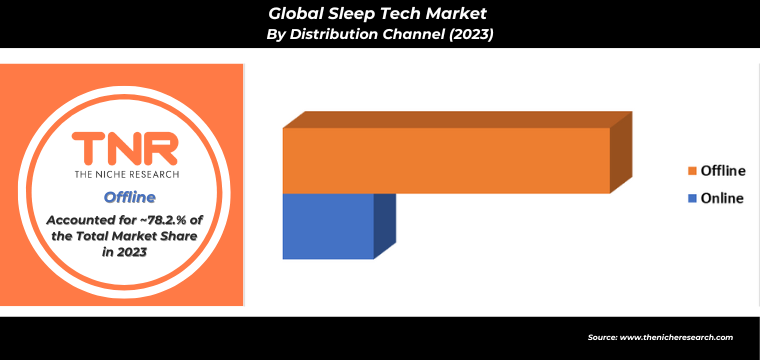
Global Sleep Tech Market By Region
Europe is anticipated as the fastest growing region during the forecast timeline. This growth is driven by increasing awareness of sleep health, rising cases of sleep disorders, and the adoption of advanced sleep monitoring technologies. Countries like Germany and the UK are witnessing a surge in demand for devices such as smart mattresses and sleep apnea machines. For example, Philips expanded its sleep solutions in Europe in 2022, enhancing accessibility to advanced sleep tech. The region’s growing emphasis on healthcare innovation and sleep wellness is fueling this rapid expansion.
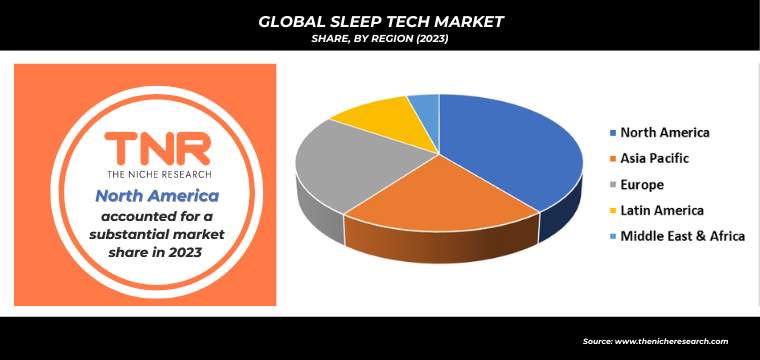
Most Downloaded Sleep Trackers
The most downloaded sleep trackers include apps like ShutEye, which uses AI to analyze sleep patterns, and BetterSleep, known for its sleep stories and relaxation techniques. These apps have gained popularity for their user-friendly interfaces and effective sleep improvement features, making them top choices among users.
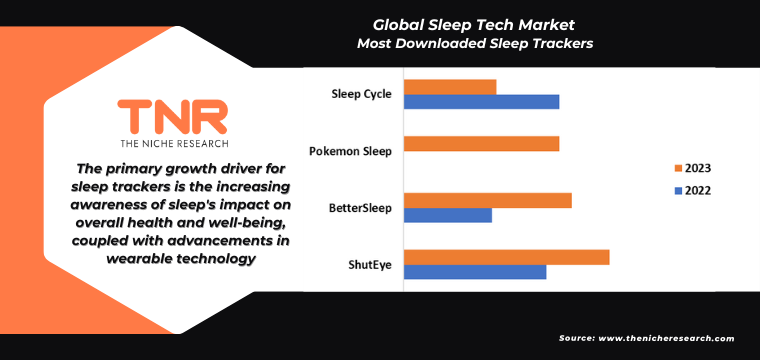
Competitive Landscape
The global sleep tech market is highly competitive, featuring major players like Philips, Fitbit, and Rhythm. These companies drive innovation with advanced products such as smart mattresses and sleep apnea devices. Competition is intensified by technological advancements and the growing demand for personalized sleep solutions. Market leaders focus on research and development to enhance product offerings, address diverse consumer needs, and maintain their competitive edge.
Some of the players operating in the sleep tech market are
- Casper
- Compumedics Limited
- Dodow
- Eight Sleep
- Fitbit
- Koninklijke Philips N.V.
- Nihon Kohden Corporation
- Nokia
- Oura Health
- Rhythm
- Sleep Number
- Sleepace
- SleepScore Labs
- Xiaomi
- Other Industry Participants
Global Sleep Tech Market Scope:
| Report Specifications | Details |
| Market Revenue in 2023 | US$ 18.4 Bn |
| Market Size Forecast by 2034 | US$ 108.6 Bn |
| Growth Rate (CAGR) | 17.5% |
| Historic Data | 2016 – 2022 |
| Base Year for Estimation | 2023 |
| Forecast Period | 2024 – 2034 |
| Report Inclusions | Market Size & Estimates, Market Dynamics, Competitive Scenario, Trends, Growth Factors, Market Determinants, Key Investment Segmentation, Product/Service/Solutions Benchmarking |
| Segments Covered | By Type, By Product Type, By Application, By Distribution Channel, By Region |
| Regions Covered | North America, Europe, Asia Pacific, Middle East & Africa, Latin America |
| Countries Covered | U.S., Canada, Mexico, Rest of North America, France, The UK, Spain, Germany, Italy, Nordic Countries (Denmark, Finland, Iceland, Sweden, Norway), Benelux Union (Belgium, The Netherlands, Luxembourg), Rest of Europe, China, Japan, India, New Zealand, Australia, South Korea, Southeast Asia (Indonesia, Thailand, Malaysia, Singapore, Rest of Southeast Asia), Rest of Asia Pacific, Saudi Arabia, UAE, Egypt, Kuwait, South Africa, Rest of Middle East & Africa, Brazil, Argentina, Rest of Latin America |
| Key Players | Casper, Compumedics Limited, Dodow, Eight Sleep, Fitbit, Koninklijke Philips N.V., Nihon Kohden Corporation, Nokia, Oura Health, Rhythm, Sleep Number, Sleepace, SleepScore Labs, Xiaomi |
| Customization Scope | Customization allows for the inclusion/modification of content pertaining to geographical regions, countries, and specific market segments. |
| Pricing & Procurement Options | Explore purchase options tailored to your specific research requirements |
| Contact Details | Consult With Our Expert
Japan (Toll-Free): +81 663-386-8111 South Korea (Toll-Free): +82-808- 703-126 Saudi Arabia (Toll-Free): +966 800-850-1643 United Kingdom: +44 753-710-5080 United States: +1 302-232-5106 E-mail: askanexpert@thenicheresearch.com
|
Key Development:
- In June 2024, Samsung announced plans to introduce its Galaxy Ring in India by August 2024. This innovative finger-worn device will track sleep patterns and monitor heart rate, among other features.
- In June 2024, Wakefit unveiled new sleep solutions powered by Artificial Intelligence in India. These solutions are designed to enhance sleep quality and overall health by integrating advanced technology into the sleep environment.
Global Sleep Tech Market
By Type
- Wearables
- Non Wearables
By Product Type
- Sleep Monitoring Devices
- Sleep Apnea Devices
- Sleep Therapy Products
- Sleep Aids
- Smart Mattresses and Bedding
- Others
By Application
- Home Use
- Professional Use
By Distribution Channel
- Online
- Offline
- Electronics Stores
- Pharmacies
- Others
By Region
- North America (U.S., Canada, Mexico, Rest of North America)
- Europe (France, The UK, Spain, Germany, Italy, Nordic Countries (Denmark, Finland, Iceland, Sweden, Norway), Benelux Union (Belgium, The Netherlands, Luxembourg), Rest of Europe)
- Asia Pacific (China, Japan, India, New Zealand, Australia, South Korea, Southeast Asia (Indonesia, Thailand, Malaysia, Singapore, Rest of Southeast Asia), Rest of Asia Pacific)
- Middle East & Africa (Saudi Arabia, UAE, Egypt, Kuwait, South Africa, Rest of Middle East & Africa)
- Latin America (Brazil, Argentina, Rest of Latin America)
Report Layout:
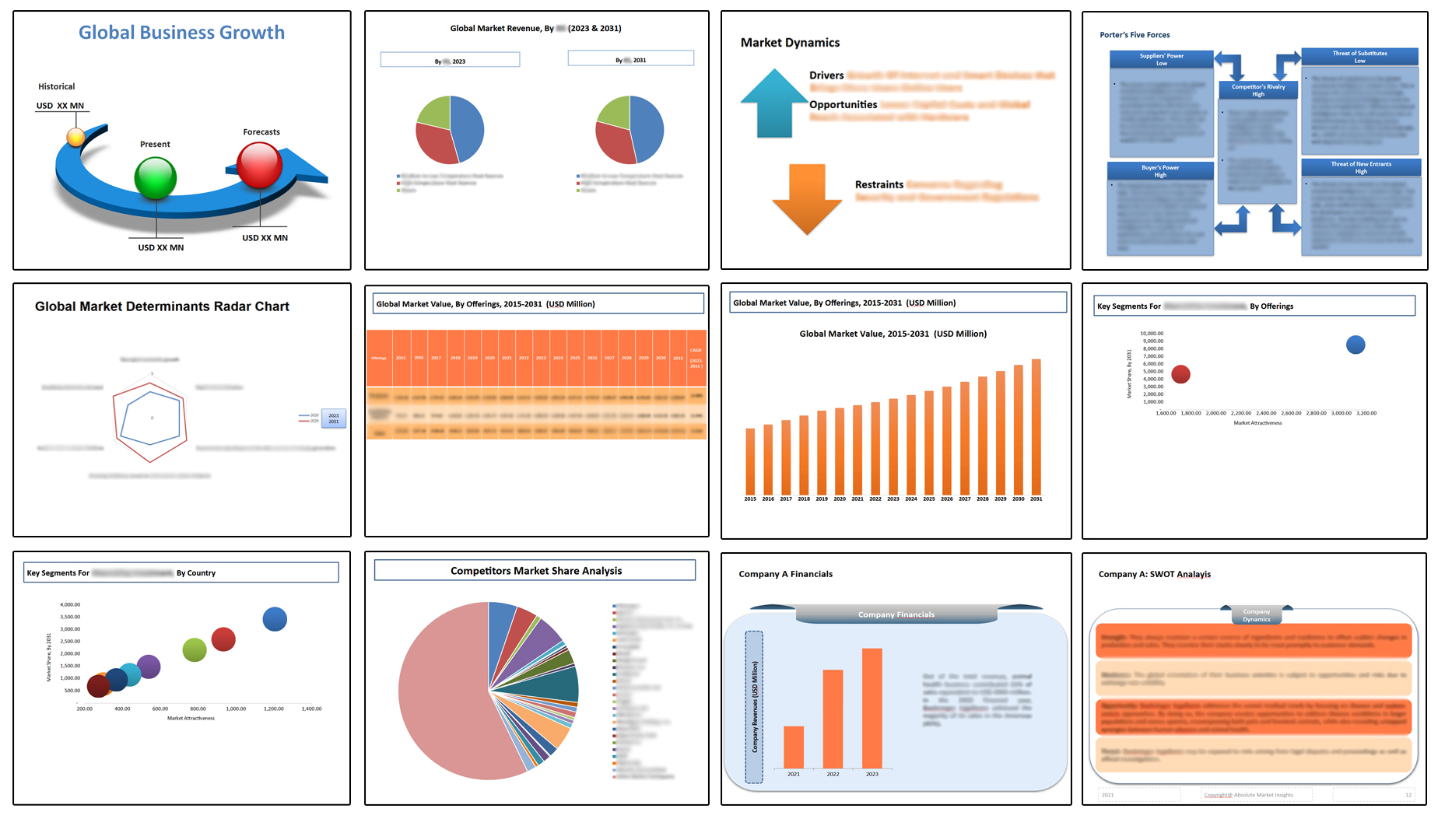
Table of Contents
Note: This ToC is tentative and can be changed according to the research study conducted during the course of report completion.
**Exclusive for Multi-User and Enterprise User.
Global Sleep Tech Market
By Type
- Wearables
- Non Wearables
By Product Type
- Sleep Monitoring Devices
- Sleep Apnea Devices
- Sleep Therapy Products
- Sleep Aids
- Smart Mattresses and Bedding
- Others
By Application
- Home Use
- Professional Use
By Distribution Channel
- Online
- Offline
- Electronics Stores
- Pharmacies
- Others
By Region
- North America (U.S., Canada, Mexico, Rest of North America)
- Europe (France, The UK, Spain, Germany, Italy, Nordic Countries (Denmark, Finland, Iceland, Sweden, Norway), Benelux Union (Belgium, The Netherlands, Luxembourg), Rest of Europe)
- Asia Pacific (China, Japan, India, New Zealand, Australia, South Korea, Southeast Asia (Indonesia, Thailand, Malaysia, Singapore, Rest of Southeast Asia), Rest of Asia Pacific)
- Middle East & Africa (Saudi Arabia, UAE, Egypt, Kuwait, South Africa, Rest of Middle East & Africa)
- Latin America (Brazil, Argentina, Rest of Latin America)
The Niche Research approach encompasses both primary and secondary research methods to provide comprehensive insights. While primary research is the cornerstone of our studies, we also incorporate secondary research sources such as company annual reports, premium industry databases, press releases, industry journals, and white papers.
Within our primary research, we actively engage with various industry stakeholders, conducting paid interviews and surveys. Our meticulous analysis extends to every market participant in major countries, allowing us to thoroughly examine their portfolios, calculate market shares, and segment revenues.
Our data collection primarily focuses on individual countries within our research scope, enabling us to estimate regional market sizes. Typically, we employ a bottom-up approach, meticulously tracking trends in different countries. We analyze growth drivers, constraints, technological innovations, and opportunities for each country, ultimately arriving at regional figures.Our process begins by examining the growth prospects of each country. Building upon these insights, we project growth and trends for the entire region. Finally, we utilize our proprietary model to refine estimations and forecasts.
Our data validation standards are integral to ensuring the reliability and accuracy of our research findings. Here’s a breakdown of our data validation processes and the stakeholders we engage with during our primary research:
- Supply Side Analysis: We initiate a supply side analysis by directly contacting market participants, through telephonic interviews and questionnaires containing both open-ended and close-ended questions. We gather information on their portfolios, segment revenues, developments, and growth strategies.
- Demand Side Analysis: To gain insights into adoption trends and consumer preferences, we reach out to target customers and users (non-vendors). This information forms a vital part of the qualitative analysis section of our reports, covering market dynamics, adoption trends, consumer behavior, spending patterns, and other related aspects.
- Consultant Insights: We tap into the expertise of our partner consultants from around the world to obtain their unique viewpoints and perspectives. Their insights contribute to a well-rounded understanding of the markets under investigation.
- In-House Validation: To ensure data accuracy and reliability, we conduct cross-validation of data points and information through our in-house team of consultants and utilize advanced data modeling tools for thorough verification.
The forecasts we provide are based on a comprehensive assessment of various factors, including:
- Market Trends and Past Performance (Last Five Years): We accurately analyze market trends and performance data from preceding five years to identify historical patterns and understand the market’s evolution.
- Historical Performance and Growth of Market Participants: We assess the historical performance and growth trajectories of key market participants. This analysis provides insights into the competitive landscape and individual company strategies.
- Market Determinants Impact Analysis (Next Eight Years): We conduct a rigorous analysis of the factors that are projected to influence the market over the next eight years. This includes assessing both internal and external determinants that can shape market dynamics.
- Drivers and Challenges for the Forecast Period:Identify the factors expected to drive market growth during the forecast period, as well as the challenges that the industry may face. This analysis aids in deriving an accurate growth rate projection.
- New Acquisitions, Collaborations, or Partnerships: We keep a close watch on any new acquisitions, collaborations, or partnerships within the industry. These developments can have a significant impact on market dynamics and competitiveness.
- Macro and Micro Factors Analysis:A thorough examination of both macro-level factors (e.g., economic trends, regulatory changes) and micro-level factors (e.g., technological advancements, consumer preferences) that may influence the market during the forecast period.
- End-User Sentiment Analysis: To understand the market from the end-user perspective, we conduct sentiment analysis. This involves assessing the sentiment, preferences, and feedback of the end-users, which can provide valuable insights into market trends.
- Perspective of Primary Participants: Insights gathered directly from primary research participants play a crucial role in shaping our forecasts. Their perspectives and experiences provide valuable qualitative data.
- Year-on-Year Growth Trend: We utilize a year-on-year growth trend based on historical market growth and expected future trends. This helps in formulating our growth projections, aligning them with the market’s historical performance.
Research process adopted by TNR involves multiple stages, including data collection, validation, quality checks, and presentation. It’s crucial that the data and information we provide add value to your existing market understanding and expertise. We have also established partnerships with business consulting, research, and survey organizations across regions and globally to collaborate on regional analysis and data validation, ensuring the highest level of accuracy and reliability in our reports.









